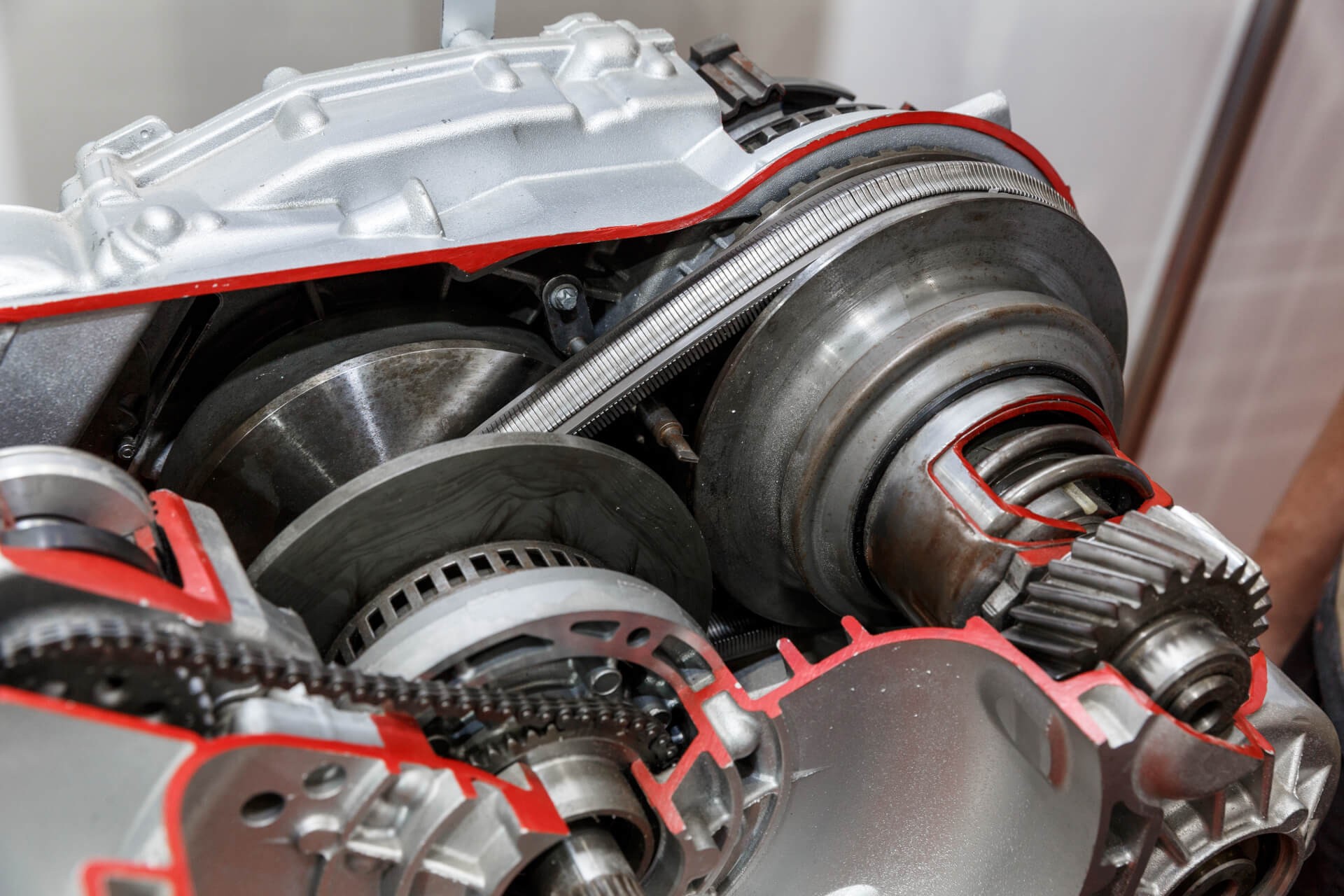Car transmissions significantly shape your driving experience, influencing the smoothness of your ride and much more. While we often discuss manual and automatic transmissions, the latter category encompasses several types. One such type is the continuously variable transmission, or CVT.
But what exactly is a CVT gearbox, how does it operate, and should you consider a vehicle equipped with one? Let’s delve into the workings of continuously variable transmissions and uncover the answers.
Understanding the CVT Gearbox
A continuously variable transmission (CVT) is a type of automatic transmission that employs a system of belts, pulleys, or chains to transfer power from the engine to the drivetrain.
Unlike traditional automatic transmissions that rely on a fixed set of gears, a CVT offers an infinite spectrum of gear ratios within a defined range. This allows the engine to consistently operate at its most efficient RPM (revolutions per minute) for any given speed and driving condition. In essence, it continuously adjusts to provide the optimal gear ratio.
How CVT Works: A Deep Dive
The most prevalent type of CVT is pulley-based. It features a metal belt or chain running between two variable-diameter pulleys. Each pulley consists of two cone-shaped halves capable of moving closer together or further apart. One pulley is connected to the engine’s crankshaft, and the other to the wheels.
Essentially, a pulley-based CVT operates by modifying the effective diameter of these two pulleys.
As you drive, your car’s computer system constantly monitors parameters such as engine speed, vehicle speed, and load. Based on this real-time data, the system adjusts the pulley halves. It moves the sheaves of one pulley closer together while simultaneously moving the sheaves of the other pulley further apart.
This adjustment changes the effective diameters of the pulleys, thus altering the gear ratio seamlessly. By continuously fine-tuning this ratio, the CVT ensures the engine consistently operates at peak efficiency.
The Driving Sensation with CVT
The fundamentally different operating principle is not the only distinction between continuously variable transmissions and conventional ones. The absence of fixed gears in a CVT, compared to the four, five, or more gears in traditional transmissions, leads to noticeable differences in driving feel.
For instance, traditional automatic and manual transmissions often exhibit perceptible shifts between gears. However, driving a car with a CVT typically results in smooth, shiftless acceleration. You won’t experience the usual jerks or lurches as the transmission seamlessly transitions through gear ratios.
This smooth, almost seamless acceleration can be perceived in different ways. Some drivers find the CVT driving experience to be somewhat bland. The feeling of engagement and connection with the vehicle can be minimal for those accustomed to feeling gear changes. You don’t hear or feel distinct shift points, and the engine sound can be consistently monotonous.
However, if you prioritize a smooth, comfortable, and efficient ride, and don’t necessarily need a strong sense of “connection” with your car’s mechanics, you’ll likely appreciate the driving experience a CVT offers.
Advantages of CVT in Cars
The increasing popularity of CVTs is prompting more car buyers to consider vehicles equipped with this type of transmission. What are the specific benefits that CVT gearboxes bring to the table?
Enhanced Fuel Efficiency
Cars with continuously variable transmissions often demonstrate superior fuel economy compared to models with conventional automatic transmissions. This advantage is particularly noticeable in stop-and-go city driving and during steady-speed highway cruising. CVTs achieve this efficiency by precisely optimizing engine speed for varying driving conditions, allowing the engine to consistently operate within its most fuel-efficient range.
Smoother Driving Experience
The absence of gear shifts in CVTs contributes to a significantly more comfortable and relaxed driving experience. This is especially advantageous in urban environments with frequent acceleration and deceleration. The seamless power delivery makes for a less jerky and more pleasant ride.
CVTs are also adaptable to different driving styles, enhancing the overall driving experience. Whether you prefer a more spirited driving style or relaxed cruising, the CVT can adjust to provide optimal performance for your specific needs.
Compact and Lightweight Design
The light and compact design of CVTs is a significant advantage, leading to further benefits.
CVTs are generally lighter and more compact than both traditional automatic and manual transmissions. Reduced vehicle weight directly translates to improved fuel efficiency, as less energy is required to move the car.
Furthermore, CVTs are compatible with a wide range of engine sizes and types. This versatility allows manufacturers to utilize smaller, more fuel-efficient engines without compromising performance. CVTs are particularly well-suited for hybrid vehicles, where their seamless integration into the powertrain maximizes efficiency.
Disadvantages of CVT Transmissions
Despite their advantages, CVTs also have certain drawbacks that differentiate them from other types of transmissions. It’s important to be aware of these potential downsides when considering a car with a CVT gearbox.
Durability and Reliability Concerns
While CVT technology is continuously improving, historically, CVTs have sometimes been perceived as less durable and reliable than conventional automatic transmissions. Earlier CVT models were often expected to last around 100,000 miles (approximately 160,000 kilometers) before potentially needing a rebuild.
However, proactive maintenance significantly impacts CVT longevity. Regular CVT fluid changes, ideally more frequently than manufacturer recommendations (perhaps every 50,000 miles or less), along with responsible driving habits and routine inspections, are crucial for maximizing CVT lifespan.
Higher Repair and Replacement Costs
Repairing or replacing a CVT can often be more expensive compared to traditional automatic transmissions. Although the initial cost of a CVT unit might be comparable or even slightly lower, replacement parts for CVTs tend to be pricier.
Furthermore, CVT repair requires specialized knowledge and tools, as it’s still a relatively newer and more complex technology compared to well-established traditional transmissions. This specialized service contributes to higher labor costs for CVT repairs.
In cases of significant CVT failure, replacing the entire transmission assembly might be more cost-effective than attempting to repair individual internal components, which can substantially increase the overall repair bill.
Noise Issues
While CVTs are generally associated with quieter operation and smoother rides in normal driving conditions, they can produce more noticeable noise during acceleration or at higher speeds. This noise is a common complaint among CVT users.
The characteristic sound, often described as a “droning” or high-pitched whine, stems from the CVT’s operational nature. As the CVT adjusts gear ratios for acceleration, the engine RPM may remain relatively constant, leading to this consistent, sometimes intrusive, sound.
Which Cars Are Equipped with CVT Transmissions?
Many major automotive manufacturers, including Toyota, Nissan, Honda, Subaru, and Audi, incorporate CVTs into their vehicles. While there isn’t a single, universal reason for this choice, the trend towards CVT adoption is clear, and their popularity is expected to grow as the technology matures.
Here’s a list of popular car models that may feature a CVT transmission. Note that for models offering multiple engine options, not all versions may be equipped with a CVT:
- Audi: A4, A5, A6, A7
- Buick: Encore GX
- Chevrolet: Spark, Malibu, Trailblazer, Volt
- Fiat: Panda, Punto, Uno
- Ford: Escape Hybrid, Fiesta, Maverick
- Honda: Accord, Accord Hybrid, Civic, CR-V, CR-Z, Insight
- Hyundai: Accent, Elantra, Kona, Venue
- Infiniti: QX50, QX60
- Kia: Forte, Picanto, Seltos, Soul
- Lexus: ES, LC, LS, LM, NX, RX, TX, UX
- Mitsubishi: Colt, Eclipse Cross, Mirage, Outlander
- Nissan: Almera, Altima, Juke, Maxima, Murano, Rogue, Qashqai, Sentra, Versa
- Renault: Kadjar, Kiger
- Subaru: Ascent, Crosstrek, Forester, Impreza, Legacy, Outback, WRX
- Toyota: Avalon Hybrid, Avensis, Corolla, Prius, RAW4, Sienna, Venza, Yaris
Is a CVT-Equipped Car Right for You?
Opinions on CVT gearboxes are divided. Some advise against them, while others recommend them. CVTs have both advantages and disadvantages, and the crucial question is whether a CVT suits your individual driving habits, priorities, and needs.
If you have a strong preference for a more traditional driving feel and enjoy feeling in direct control of gear shifts, a CVT might not be the ideal choice. However, if you prioritize a smooth, fuel-efficient, and comfortable ride, particularly for urban driving, you will likely appreciate the benefits of a CVT gearbox.
The best way to determine if a CVT is right for you is to test drive cars equipped with this type of automatic transmission. Experiencing the driving feel firsthand will help you decide if it aligns with your driving style and comfort preferences.
Check Your VIN
Ensure peace of mind by checking a vehicle’s history before making a purchase. Get an instant report to uncover potential hidden issues.

